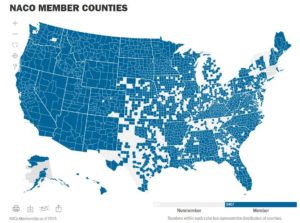To provide county government leaders with an opening framework to the connected and automated vehicles (CAVs) conversation and advice on how they may enter the field, the USA’s National Association of Counties (NACo) has created a new ‘toolkit for its membership.
Technology manufacturers, software developers, auto companies, universities and many other professionals have long been imagining and testing a variety of techniques to optimize the country’s transportation system through the use of integrated technology, communications, vehicles and infrastructure. These breakthroughs are poised to revolutionize local and national transportation systems and could bring significant changes to the built environment and how residents live, work and move around the community. Representing over 2,400 of the USA’s 3,069 county governments, NACo notes that as significant advances in transportation technologies continue to be made, and although city and state organizations have been offered multiple sources of guidance, it is also imperative that county officials, county engineers and transportation planners understand these advancements when making decisions about their future needs.
NACo has now released the ‘Connected and Autonomous Vehicles Toolkit: A Primer for Counties’ to provide essential information on the new technologies for its membership and help counties prepare for the future of transportation and the infrastructure it will require. The primer has four main sections: Technology, policy, deployment and next steps. With the fast pace of technological advancements in the CAV industry, it can be hard for government policy and procurement systems to keep pace. The technology section provides an introduction to connected and self-driving vehicles and the technologies developed to support them, while the policy section provides an overview of current CAV-related policy at the federal, state and local levels. With a basic understanding of current technology and policy in place, the toolkit then sets the stage for the current state of CAV deployment at the federal, state and local government levels, as well as within the automotive industry.
Each of the Toolkit’s sections highlights useful existing resources that have been created to track and showcase these advancements, from the National Highway Traffic Safety Administration’s (NHTSA) ‘Automated Vehicles for Safety’ webpage to the National Conference of State Legislatures’ ‘Autonomous Vehicles State Bill Tracking Database’, as well as NACo’s own ‘Connected Counties: Tech Innovations in Transportation’ publication and the National League of Cities’ ‘Autonomous Vehicle Pilots Across America’ report.
NACo says there are a number of ways that county leaders can make use of new technology innovations to facilitate transportation services’ design and delivery, improve public safety, and promote local and regional economic development. By making minute changes to infrastructure and policies today, counties can prepare themselves to be at the forefront of the mainstream application of CAV technology in the future. NACo’s new toolkit primes county officials to determine if their counties have potential to be leaders in the continued development of the CAV field whether via the adoption of local policies or the deployment of self-driving vehicles on local roads.





